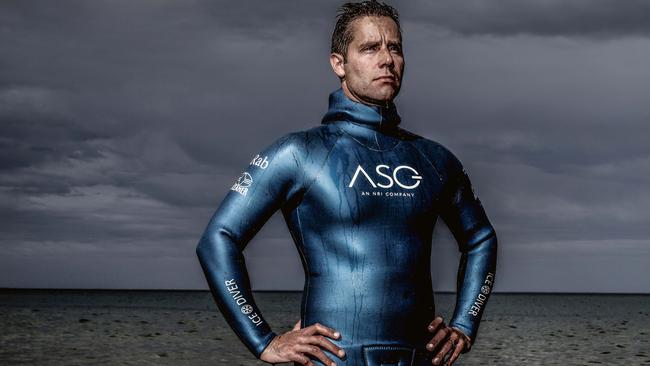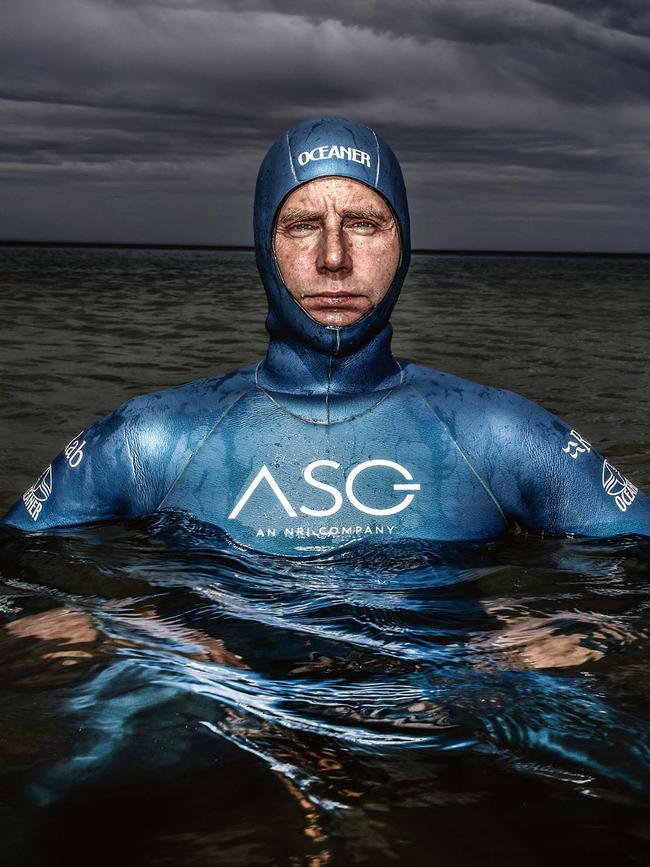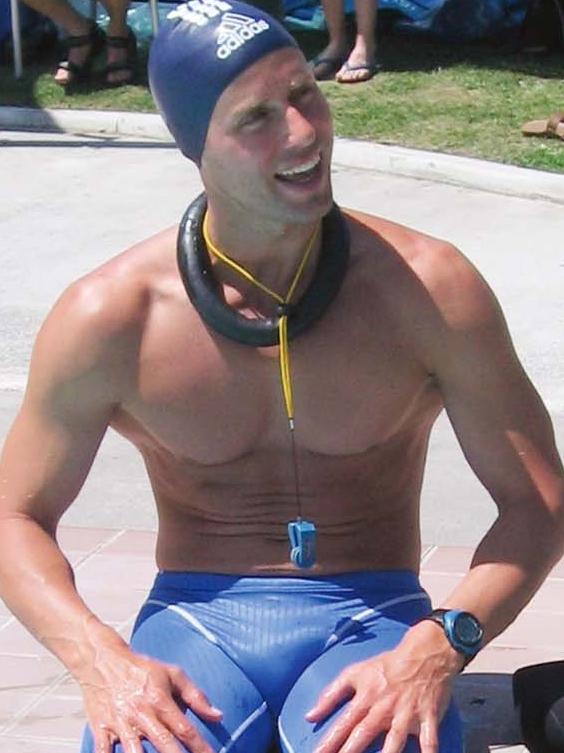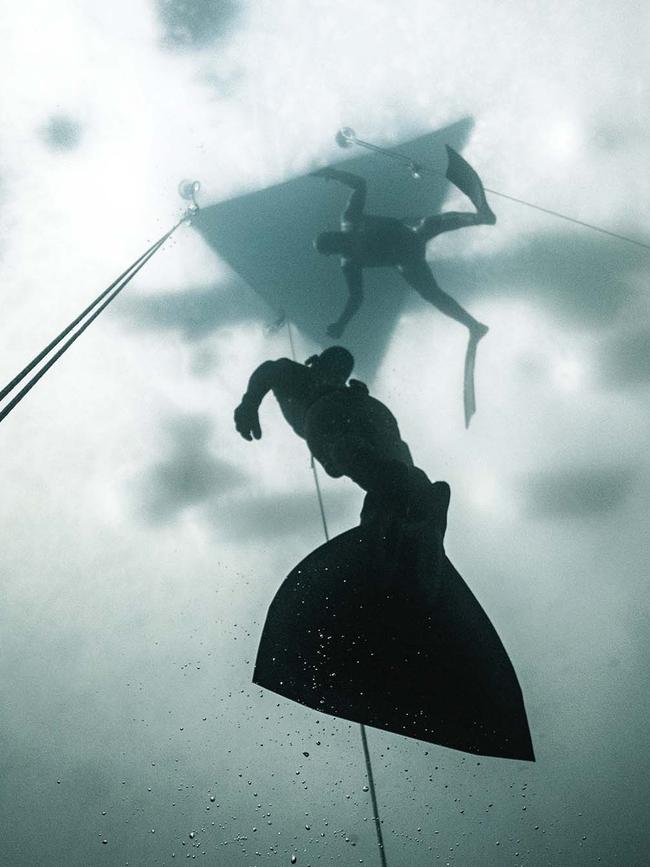Freediver Ant Williams aims to go deeper under ice than anyone before
What Ant Williams does is so dangerous, so on the fringes of an already extreme sport, the world body won’t even recognise it.

Dawn is breaking over a car park on Victoria’s Torquay beach, a light breeze rakes the caramel sand and the man I met 15 seconds ago has just asked me to undress. Ant Williams eyes me up and down and then slides a two-litre bottle of clear liquid across the bonnet of his car towards me. “Go easy on it,” he says with a wink. “This is high grade sex lube.”
It’s not easy wrestling a dry body into a wetsuit. Together we lube up and slide our bodies into our new skin. My skinny frame flops around absurdly inside the folds of the wetsuit; Williams fills out his in a more flattering way. The 47-year-old Kiwi sports psychologist turned freediver is carved from the finest marble but beauty isn’t skin deep. Beneath the overinflated pectorals lies one of the greatest set of lungs the world has known.
Freediving is about diving, often to great depths, without air tanks — just you, your lungs, your mind and whatever battle to the death is being fought between them. Williams competes in the “Constant Weight” discipline. Other disciplines allow a diver to plummet using a weighted sled and to ascend with the aid of a balloon, or by pulling on the dive-line — but in Constant Weight a diver relies only on fins (or a monofin) for propulsion, cannot alter his or her weights during the dive, and cannot pull on the dive-line.
Williams has won the USA National Freediving Championships and has been ranked third in the world for breath-hold swimming. He can hold his breath for more than eight minutes underwater and can store enough air inside that massive chest cavity to dive to a depth of 100m. (The Constant Weight world record of 130m was set by Russian freediver Alexey Molchanov last year in the Bahamas.) Next week Williams will call those lungs into action in the waters off Kirkenes in northern Norway, when he will attempt to dive deeper than any person ever has under ice. He hopes to reach 75m, beating the current world record of 65m set at the North Pole in 2015 by another Russian, Konstantin Novikov.
It’s a mission so dangerous, so on the fringes of what’s already considered an extreme sport, that the world freediving governing body won’t even recognise it. But Guinness World Records will. More importantly, Williams will recognise it. He’ll call on all those techniques he learnt while working as a sports psychologist, and what he teaches others now as a leadership coach: reframing, visualisation, thought-stopping. Only then, when he fulfils his dream to be the deepest man under ice, will he make peace with himself and recognise maybe what he used to believe was wrong. Maybe he’s not a fraud after all.

The ocean off Williams’ home in Torquay, south-west of Melbourne, ishis training pool. Today is his last session before he starts the journey to Norway. We take a jetski out to the dive spot 3km offshore; Williams drives, his training buddy Danny Hurst is in the middle and I cling on for dear life behind. The swell rises and drops and Williams works the throttle, launching us off crests, scattering flocks of muttonbirds and gulls. The waking sun sends shards of lemony light through the dissipating cloud and the water shimmers like crystal.
Finally he cuts the throttle, checks the depth and drops an anchor. I lower myself into the water and hold onto a small, floating pontoon tethered to the jetski while Williams and Hurst don masks and nose clips and prepare to dive. Williams is only going down 65m today; child’s play, really. But to simulate the last stages of a deep dive, he’ll expel some of the air from his lungs before descending. He pulls on his last piece of equipment, a carbon fibre monofin Hurst has fashioned for him. “Danny,” he says, running his fingers over the sleek fin. “This is beautiful.”
The water is a balmy 21ºC, clear and clean; sunlight slices the surface and lights the underwater world. But right now Williams has to block it out and visualise the Artic, believe he’s staring into the frigid water, about to get the call to go.
“Your turn!” calls Williams. He’s come up from histraining dive and before I can protest he is strapping a weight-belt around my waist and adjusting my mask. “I’ll swim down five metres and wait for you. When you’re ready, just dive towards me and try to stay calm.” Easy for the ice man to say. He turns, breaching like an orca, and disappears. He belongs down there; I don’t. I count to 10, take a deep breath and dive.
I swim a couple of strokes vertically down then pause to equalise my ears, as I’d been instructed. I see Williams below me, on his back, arms and legs gently curling upwards, flayed out like an astronaut floating in space.
Suddenly my chest tightens. He’s too far away. I’m diving down too far, it’s not right. What am I doing? Panic sets in. I need air more than I’ve ever needed anything in my life. Before I know what I’m doing I turn and swim with everything I have for the surface. I grab the side of the pontoon and suck in that wonderful first breath. Moments later, Williams pops up beside me and smiles. I’d gone less than three metres.
On his last dive Williams seems to be under the water an eternity. I sit idly on the pontoon while it bobs on the swell like a life-raft. Muttonbirds dive for fish around us while Hurst silently monitors the safety rope. Finally he pops up, sucking and expelling air in rapid-fire bursts. Minutes later he’s on the jetski, packing up, when he starts making guttural noises, like someone about to vomit. Hurst looks over and shakes his head casually. “This happens a lot.” A moment later Williams pulls himself together and resumes hauling in the rope. “Seasickness,” he explains. “It’s a bloody curse.”

Back on dry land, Williams’ freediving friends Jarrod Briffa and Nick Rhoden join us diving into plates of scrambled eggs and avocado on toast. It’s the post-dive cafe debriefs where battle stories are shared. “It’s a total out-of-body experience when you dive,” says Rhoden. “Like a period of meditation, where you’re not really in your body or in your mind, you’re somewhere else.” Briffa says the exaltation comes from unlocking that new realm, going to a place outside the world as we know it, outside even consciousness itself.
“But that’s what attracts me to the sport,” says Williams. “Being under water, where you’re not supposed to be, and having a sense of control; at least some control. Staying completely centred and relaxed in a strange, foreign environment. There’s something magical about that.”
The first five metres of a dive takes the most effort. Even with a weight-belt you need to kick and swim hard to overcome the buoyancy of your wetsuit and full lungs. At 20m things get a little easier; the water pressure has compressed your lungs to the point that you become “negatively buoyant” and you start to freefall down. “This is the moment of surrender,” says Rhoden. “This is what it’s about. You just let it happen.”
They all speak of it. That moment of peace when you don’t need to think, you don’t need to act, you just fall head-first towards the ocean floor. To freedive is to search for the meaning of surrender.
“Surrender to me means…” Williams searches for it. “It means losing that self-doubt, putting aside all those negative thoughts, trusting in yourself.”
He tells a story. He was competing in the world championships in Turkey, waiting for his turn to dive, watching the wind whip up whitecaps, nervously fidgeting. For years he hadn’t been able to dive deeper than 55m. “I’m sitting on the boat, stressing out, and next to me is a Finnish diver called Topi Lintukangas. He’s an introvert, normally never speaks to anybody, but he turns to me and says, “You know what your problem is? You don’t know how to surrender. You keep fighting. Until you learn how to let go, to let yourself be crushed, you’re never going to be a diver.”
When Williams walks out onto the ice in Norway he will have visualised the scene a thousand times. There’s a log cabin beside a frozen fjord. Outside it’s minus 25°C. The previous day his crew will have taken a chainsaw out onto the ice and cut a hole through it. It’ll look like a portal to hell, the manhole of his nightmares. He’ll stand on the edge and look into the water. It won’t be blue like the summer sea in Torquay. It won’t shimmer in the sun. It will be as black as the worst night of your life. The darkness compounds the dangers of nitrogen narcosis, a change in consciousness brought on by the narcotic effect of air in the lungs being absorbed under great pressure. It’s the narcosis that alters judgment, causing mistakes that can kill you. Fear will raise your pulse rate and make you want to breathe faster. You need to control that, slow it down. Control your fear and you can control your life.
The water temperature will be about 0.2°C. If the narcosis doesn’t get him, the hypothermia might. He’ll fight every primal urge in his body that screams at him not to go near that death hole, to walk back across the ice and into the warmth of the log cabin. Then he’ll take a final breath and dive into the abyss.
While he’s in Norway holding his breath under ice, his wife Merryn will be holding hers back in Torquay with their children Luc, 13, and Chloe, 10. It will be their 11th wedding anniversary. Childhood sweethearts in New Zealand, they moved to Australia shortly after Luc was born. If freediving has shown Williams what he has inside him, fatherhood has brought the gift of perspective. “I suspected I would love being a dad,” he says. “But I was so apprehensive. I worried it would constrain my life, which I guess had been a pretty… not selfish, but you know, you focus on yourself a lot. With Luc and Chloe I’ve found a whole new level of enrichment.”

Williams took the plunge into freediving at the age of 30. He’d trained as a sports psychologist and quickly became sought-after, his clients coming from high-risk sports: motorcycle racers, BASE jumpers, cage fighters, big-wave surfers. Williams equipped each of them with the tools needed to face their most formidable opponent: their own mind. It was while working in France with MotoGP riders that a life-changing realisation hit. “Here I was telling these people how to do their high-risk sport better, how to understand the mental aspect of what they were facing, when I had never experienced that myself. I didn’t know what it was like to take a risk. I realised I was a complete fraud.” He looked around for a high-risk sport to take up. The options were bull fighting or freediving. It was an easy choice.
It takes about a minute to dive to 100m. By the time you hit 20m and start freefalling the water pressure is already crushing your body. Williams doesn’t call it pain, he calls it “brutal discomfort”. At 50m your lungs are so compressed it’s impossible to continue “equalising” the pressure between your inner ears and the underwater environment — a critical step — in the normal way. So on deep dives Williams uses the “mouthfill” technique: at around 20m he performs a sort of internal contortionist trick, shifting some of the air from his lungs into his cheeks. He uses that stored air to equalise when he gets past 50m, manipulating his tongue, neck and jaw in order to move the air from his cheeks into his sinuses and inner ears. To demonstrate, he mimes what looks like a cat vomiting a fur ball.
Blacking out is the biggest risk in the last third of the dive, during the ascent. It’s happened to Williams at least 10 times in the pool, and once after surfacing from a dive in which he’d struck his head on the bottom plate 82m down. There’s not much your safety crew can do in that situation except wait and hope you wake up. He woke up.
Assuming you’ve shuffled your air correctly and equalised your ears, you’ll be ready for when nitrogen narcosis really sets in at about 70m. It’s different to the decompression sickness (“the bends”) suffered by scuba divers who go deep and surface too quickly, in that it doesn’t affect the tissues in your body; it affects your mind. “Suffering narcosis is like being constantly drunk,” says Williams. “You start to make bad decisions, just like when you are drunk, I guess.”
Between 70m and 100m the discomfort reaches a new brutality. “It feels like someone’s trying to insert a pétanque ball into your chest and pull it out your back.” Williams is reliving the first time he went to 100m. It was 2012, in a sinkhole in the Bahamas called Dean’s Blue Hole, which plummets 202m straight off the sand. The signs were ominous: the sky was grey; the diver before him had blacked out. Through the dive Williams had Topi Lintukangas’s tip ringing in his perfectly equalised ears: Let yourself go. Surrender. Let it happen.
It happened. “Breaking through the surface was the most incredible physical experience I’ve ever had in my life,” he says. “Getting through something that terrifies me, going that deep and getting back to enjoy it with my friends around me, it was just incredible.”
The day of the Torquay training dive is a busy one for Williams. That night he hosts a fundraising event at Melbourne’s Espy Hotel. Becoming the deepest man under ice doesn’t come cheap. Merryn holds a camera and snaps photos of the room, all those people shaking her husband’s hand, listening intently, gazing in wonder as he recounts scarcely believable stories from a life under water, laughing at his laconic Kiwi humour. Luc and Chloe sit in the front room and beam as dad speaks, then wrap themselves around him when he joins the crowd, basking in his celebrity and his warmth. They know they are closer to this superman than anyone in the room, because his fearlessness flows through them.

To join the conversation, please log in. Don't have an account? Register
Join the conversation, you are commenting as Logout